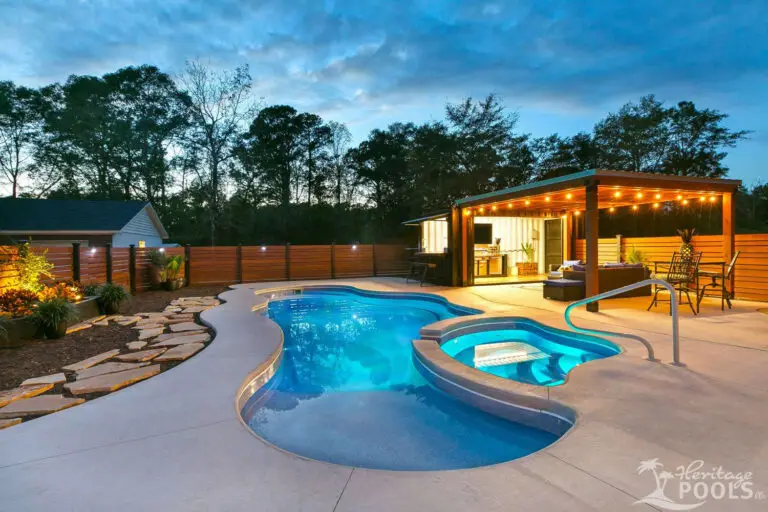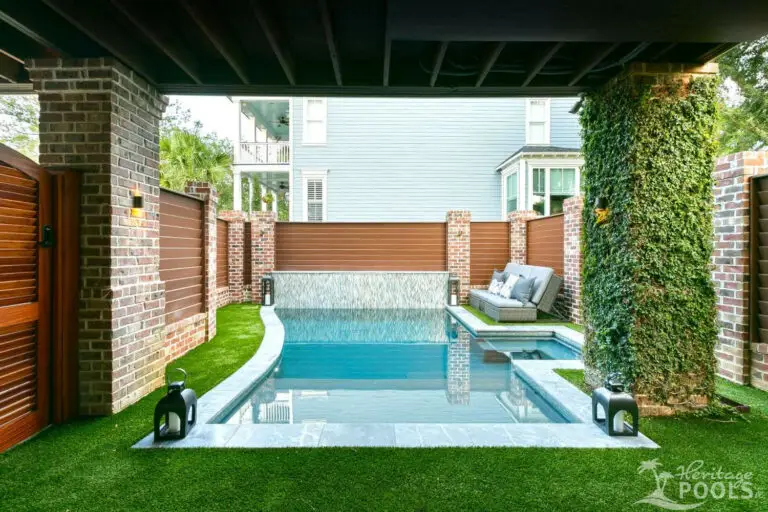Pool plaster is a mixture of cement, sand, and water that is applied to the interior of a swimming pool to provide a smooth, waterproof layer for the pool surface. The plaster can be dyed or colored to give the pool a unique look.
Plastering a pool is a common practice because it is vital to the inground pool structure and provides a clean and smooth surface.
Table of Contents
- How long does pool plaster last?
- Several factors affecting the lifespan of plaster
- How to extend the lifespan of pool plaster?
- Swimming Pool Resurfacing – Signs It’s Time to Resurface Your Pool
- Best Time of Year for Pool Resurfacing
- Cost to Resurface a Pool
- The Pros and Cons
- FAQs
- Pool Replastering for Charleston Pool Owners
How long does pool plaster last?
The lifespan of pool plaster depends on many factors, such as the quality of the plaster, the water chemistry, and the maintenance practices. On average, a well-maintained pool plaster can last between 7 to 12 years.
However, some swimming pool owners have reported that their plaster lasted for more than 12 years.
Types of Pool Plaster
There are several types of pool plaster available, each offering unique benefits and characteristics:
- White Plaster: The most traditional option, white plaster is made from white Portland cement, limestone or marble sand, and water. It provides a clean, timeless look that many pool owners prefer.
- Colored Plaster: By adding pigments to the plaster mix, pool owners can choose from a range of colors to complement their pool’s surroundings. This option allows for greater customization and can enhance the overall aesthetic of the swimming pool.
- Quartz Plaster: This type of plaster includes quartz aggregate, which adds durability and resistance to stains. It’s an excellent choice for pool owners looking for a long-lasting, low-maintenance option.
- Pebble Plaster: Incorporating small pebbles into the plaster mix creates a textured, slip-resistant surface. Pebble plaster is not only visually appealing but also practical, providing added safety for swimmers.
Several factors affecting the lifespan of plaster
- Aggressive Water chemistry – The pH, alkalinity, and calcium levels of the pool water can affect the lifespan of pool plaster. High levels of acidity can cause the plaster to erode faster.
- Usage – The frequency of use of the pool can also impact the lifespan of the plaster. Pools that are used more often tend to wear out faster than those that are used less frequently.
- Maintenance practices – Regular maintenance practices such as cleaning and balancing the chemicals in the water can increase the lifespan of pool plaster.
- Climate – The climate can also play a role in the lifespan of the plaster. Pools in areas with extreme weather conditions may experience more wear and tear than those in moderate climates.
How to extend the lifespan of pool plaster?
- Regular maintenance – Regular cleaning, brushing, and balancing the chemicals in the water can increase the lifespan of pool plaster.
- Proper water chemistry – Maintaining the proper pH, alkalinity, and calcium levels can also help to extend the lifespan of pool plaster.
- Avoid sharp objects – Avoid placing sharp or heavy objects in the pool as they can cause damage to the plaster.
- Hire professionals – Hiring professionals for pool maintenance can help identify any issues and address them before they become bigger problems.

Acid Wash
An acid wash for a concrete pool is a process of using a mixture of muriatic acid and water to remove stains, scale, and other discolorations from the surface of a concrete pool. The acid solution is applied to the pool’s walls and floor using a brush or sprayer, and then rinsed off thoroughly with water. This process is typically done when the pool is drained for maintenance or repair work.
Strong acid washing can help to restore the appearance of a concrete pool that has become discolored or stained over time. However, it should only be done by a professional who has experience working with acid and knows how to handle it safely. Improper use of acid can damage the pool’s surface or harm the person performing the acid wash, so it’s important to follow all safety guidelines and use appropriate protective equipment.
Swimming Pool Resurfacing – Signs It’s Time to Resurface Your Pool
- Jagged plaster or rough surfaces: Over time, the surface of a concrete pool can become rough and worn due to exposure to chemicals, sunlight, and other factors. This can make for uncomfortable swimming and may also cause skin irritation.
- Stains and discoloration: If the pool has stains or discoloration that can’t be removed with standard cleaning methods, it may be a sign that the surface is damaged and needs to be resurfaced. Some of the most common mineral stains in plastered pools include calcium, iron, and copper. When these minerals are present in the water in high concentrations, they can precipitate out and form deposits on the pool’s surface.
Calcium stains typically appear as white or grayish deposits on the pool’s walls or floor. Iron stains can be reddish-brown or black in color and are often caused by the use of iron-rich well water. Copper stains can be green or blue in color and may be caused by the use of copper-based algaecides or other pool chemicals. - Cracks and chips: Cracks and chips in the pool’s surface can be unsightly, expose the underlying concrete, and can also lead to leaks. If the damage is severe or widespread, resurfacing may be necessary.
- Excessive water loss: If you’re noticing that your pool is losing more water than usual, it could be a sign that the surface is damaged and needs to be resurfaced.
- Age: You need to replaster if your pool is over 10-15 years old and has never been resurfaced. Over time, the surface of a concrete pool can deteriorate and become more prone to damage and wear.

Best Time of Year for Pool Resurfacing
In general, it’s best to schedule pool resurfacing during a time when the weather is dry and mild, with temperatures between 50-90 degrees Fahrenheit. This will allow the resurfacing materials to cure properly and ensure that the process is completed efficiently.
Spring and fall are often good times to schedule pool resurfacing, as the weather is typically mild and contractors may have more availability during these seasons. However, it’s important to avoid scheduling resurfacing during periods of extreme heat or cold, as this can affect the curing process and result in less durable finishes.
Ultimately, the best time to resurface a concrete pool will depend on your specific circumstances and the recommendations of your pool contractor. Be sure to consult with a professional to determine the best time to complete this important maintenance task.

Cost to Resurface a Pool
The cost of replastering a concrete pool can vary depending on a number of factors, including:
- Size of the pool: The larger the pool, the more materials and labor will be required.
- Condition of the pool: If the pool is in poor condition and requires extensive repairs or surface preparation.
- Type of plaster: There are different types of pool plaster available, each with different cost levels. For example, standard white plaster is typically the most affordable option, while colored or specialized finishes may be more expensive.
- Contractor fees: Experienced and reputable contractors may charge more for their services than less experienced or unlicensed contractors.
- Location: Labor and material costs can vary by region.
- Additional features: If the pool has additional pool features such as steps, benches, or decorative tile work, these may require additional time and materials.
The Pros and Cons
Replastering a concrete pool can have both pros and cons.
Pros:
- Improved Aesthetics: A new plaster surface can give your pool a fresh and updated appearance.
- Smooth Surface: A new plaster surface can also create a smooth and comfortable swimming experience for users.
- Enhanced Durability: Replastering can add to the longevity of the pool, especially if the current plaster is old, deteriorating, or cracking.
- Increased Resale Value: A newly plastered pool can make your home more attractive to potential buyers if you plan to sell it in the future.
Cons:
- Cost: Replastering a pool can be expensive, and the cost will depend on the size and condition of the pool, as well as the type of plaster used.
- Time: Replastering a pool is a time-consuming process and can take several days or even weeks, depending on the size and condition of the pool.
- Disruption: The replastering process can be disruptive to your daily routine, as the pool will be out of commission during the process.
- Maintenance: Replastering is not a one-time fix; ongoing maintenance and upkeep will be required to keep the plaster in good condition.
FAQs
How often do you replaster a pool?
Every 7 to 12 years.
What is the lifespan of pool plaster?
Depending on care and maintenance, 7 to 12 years.
How long does Pebble Tec last?
10-15 years with good maintenance.
Pool Replastering for Charleston Pool Owners
Pool plaster can last between 7 to 12 years, depending on various factors such as water chemistry, maintenance practices, and usage. To extend the lifespan of pool plaster, regular maintenance, and proper water chemistry are essential.
By taking these simple steps, you can ensure that your pool plaster lasts longer, providing you with a beautiful and well-maintained swimming pool for years to come.




